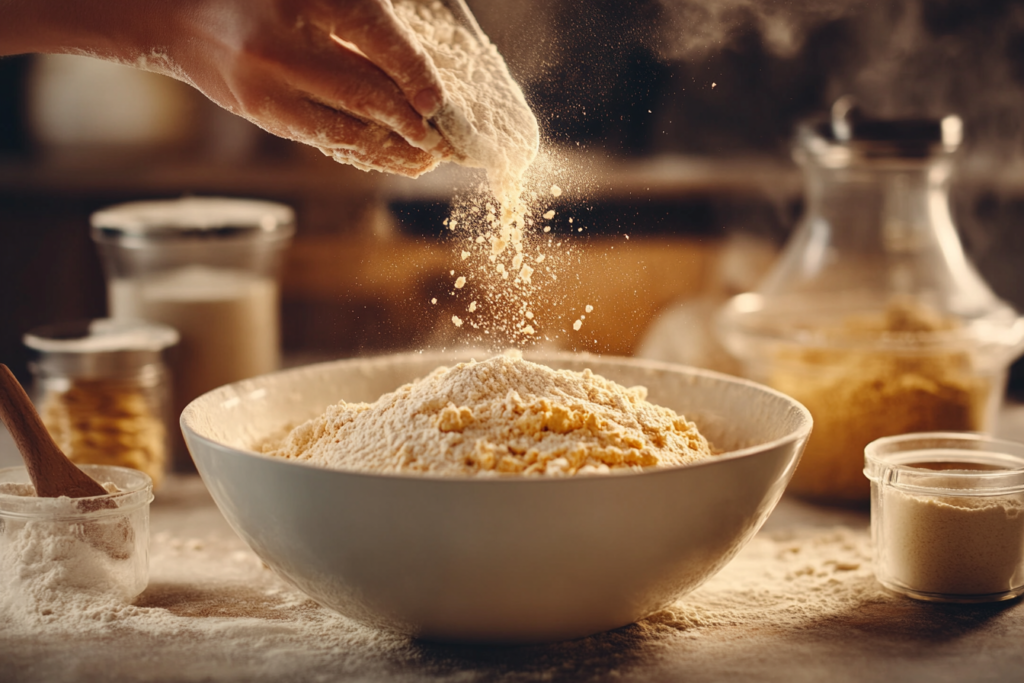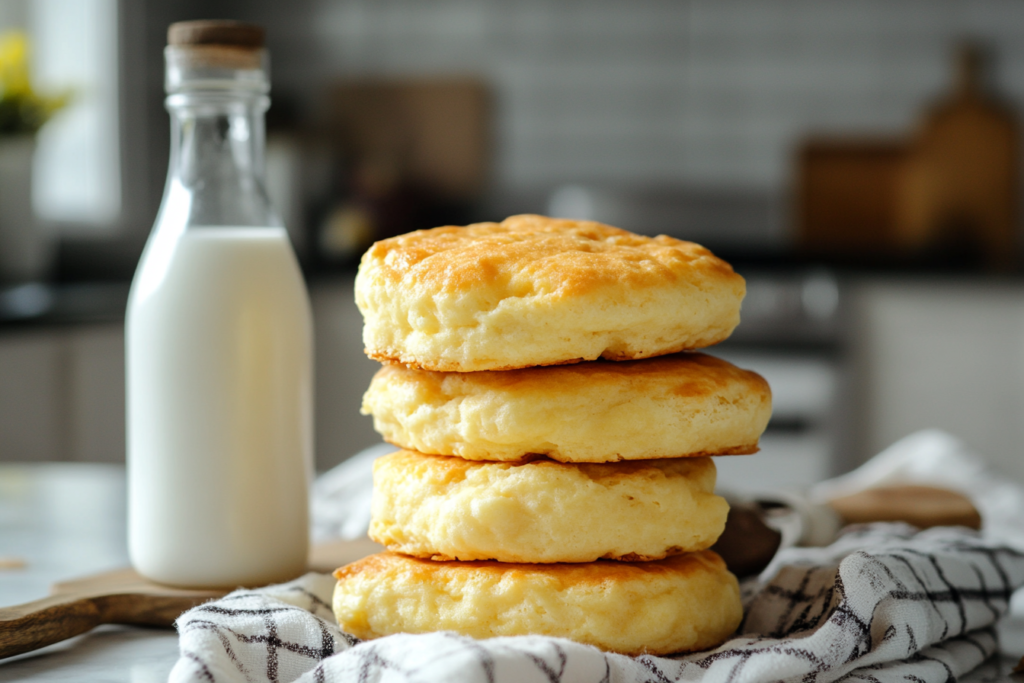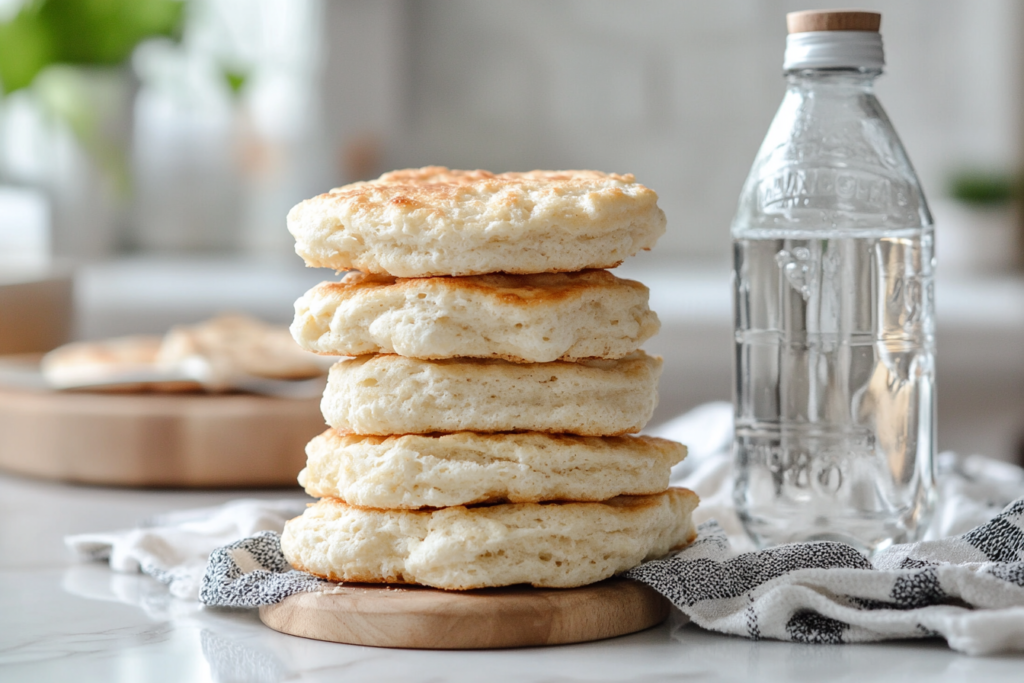Table of contents
- Introduction
- Ingredients in Bisquick
- The Role of Liquids in Bisquick Recipes
- Water vs. Milk: Key Differences
- How Milk Affects Bisquick Recipes
- How Water Affects Bisquick Recipes
- Comparing Results: Water vs. Milk
- Adjusting Recipes for Optimal Results
- Expert Opinions
- Alternative Liquids for Bisquick Recipes
- Frequently Asked Questions
- Conclusion
Introduction
When cooking with Bisquick, a common question arises: Is Bisquick better with water or milk? This choice can significantly impact the flavor, texture, and overall outcome of your recipes. Whether you’re whipping up pancakes, biscuits, or waffles, understanding the differences between water and milk in Bisquick recipes is key to achieving the perfect dish. In this article, we’ll explore which liquid works best and why.
Ingredients in Bisquick
Core Ingredients
The magic of Bisquick lies in its carefully curated blend of ingredients. A standard box contains:
- Enriched Flour: The primary base, enriched with nutrients like iron and B vitamins.
- Hydrogenated Vegetable Oil: Provides the fat content needed for tender baked goods.
- Leavening Agents: Baking powder and sodium aluminum phosphate help the dough rise.
- Salt: Enhances flavor.
- Sugar: Adds a hint of sweetness.

This combination ensures a balanced mix that’s ready to go without any additional effort.
How These Ingredients Interact with Water and Milk
When you add a liquid—whether water or milk—the dry ingredients in Bisquick spring into action. The flour absorbs the liquid, creating a batter or dough, while the leavening agents produce carbon dioxide, making your pancakes fluffy or your biscuits light. The fat in the mix contributes to a tender texture, and the salt and sugar bring flavor depth.
However, the choice between water and milk can significantly influence how these ingredients work together. Milk adds richness and creaminess, while water creates a lighter, leaner result. Understanding this interplay helps you customize recipes to your taste and dietary needs.
The Role of Liquids in Bisquick Recipes
Why Liquid is Essential
In Bisquick recipes, liquid acts as the glue that binds everything together. It hydrates the dry ingredients, activates the leavening agents, and determines the batter or dough’s consistency. Without liquid, the ingredients would remain a powdery mix, unable to transform into the fluffy pancakes or tender biscuits we all love.
The type of liquid you use also plays a crucial role in flavor, texture, and appearance. While water is a convenient option, milk introduces additional proteins and fats, which can elevate the end product.
Comparing Water and Milk as Liquids in Recipes
Let’s face it: not all liquids are created equal. Water and milk each have their strengths and weaknesses when it comes to cooking with Bisquick.
- Water: It’s simple, accessible, and calorie-free. Water creates a clean, neutral base, allowing the flavor of toppings or other ingredients to shine. However, it lacks the creamy richness that milk provides.
- Milk: Packed with fats and proteins, milk enriches the batter, making it creamier and more flavorful. It also contributes to a golden-brown finish, thanks to the natural sugars and proteins caramelizing during cooking.
The choice between the two ultimately depends on your recipe goals and dietary preferences.
Water vs. Milk: Key Differences
Nutritional Differences
From a nutritional standpoint, milk and water are worlds apart. Milk contains proteins, fats, vitamins, and minerals like calcium, while water is purely hydrating and calorie-free. Here’s a quick comparison:
- Water: Zero calories, no fats, no proteins, and no additional nutrients.
- Milk: A single cup of whole milk has about 150 calories, 8 grams of fat, 8 grams of protein, and significant amounts of calcium and vitamin D.
For those counting calories or avoiding dairy, water may seem like the obvious choice. However, milk’s nutritional profile adds more than just calories—it can also improve the structure and flavor of your recipes.
Taste, Texture, and Appearance Differences
The choice between water and milk influences three key aspects:
- Taste: Milk enhances the flavor of baked goods, adding a subtle sweetness and creaminess. Water, on the other hand, keeps the flavor neutral.
- Texture: Milk’s fat content makes for a richer, denser texture, while water results in a lighter, airier product.
- Appearance: Recipes made with milk tend to have a golden-brown finish, thanks to the Maillard reaction between milk proteins and sugars. Water-based recipes may appear paler and less visually appealing.
How Milk Affects Bisquick Recipes
Enhancing Flavor
Milk is a game-changer when it comes to flavor in Bisquick recipes. It adds a subtle creaminess that enhances the natural sweetness of pancakes or biscuits. The milk fats carry flavors better than water, giving your dishes a richer and more indulgent taste. If you’re making recipes like waffles or shortcakes, milk can amplify the flavor and make the overall experience feel more homemade.
Ever notice how store-bought pastries seem just a bit plain? That’s because they often rely on water-based recipes for cost-effectiveness. When you use milk instead, you introduce a layer of complexity that’s hard to achieve otherwise. Whether it’s whole milk, skim, or even plant-based options, the results are often a step above.

Adding Creaminess
When it comes to texture, milk doesn’t just hydrate the dry mix—it transforms it. The fats and proteins in milk give Bisquick recipes a luxurious, creamy consistency. This is especially noticeable in pancake batters, where milk creates a velvety texture that makes each bite feel soft and fluffy.
Milk also contributes to the crumb structure in biscuits, making them tender and moist rather than dry or crumbly. For recipes like pot pies or cobblers, milk can create a richer, more cohesive dish that feels heartier and more satisfying.
Impact on Texture
The texture is one of the most noticeable differences when using milk in Bisquick recipes. Milk adds density and richness, making pancakes thick yet tender and biscuits that are flaky but not crumbly. This texture is achieved because milk proteins interact with the gluten in flour to create a more structured batter or dough.
Milk’s effect on texture also extends to the browning process. Recipes made with milk achieve a beautifully golden crust, thanks to the sugars in milk caramelizing during cooking. This browning adds both visual appeal and an extra layer of flavor, making your creations look and taste gourmet.
How Water Affects Bisquick Recipes
A Lighter, Less Creamy Alternative
Water might not bring the same richness as milk, but it has its advantages. When used in Bisquick recipes, water produces lighter, airier results. This can be especially appealing for those who prefer a more delicate texture in their pancakes or biscuits.
For example, if you’re making a recipe that’s already heavy with additional ingredients—like blueberry pancakes or sausage biscuits—water can prevent the dish from feeling overly dense. It allows the main ingredients to shine without overwhelming your palate with richness.

When Water Works Better
Water excels in certain situations where simplicity and lightness are key. If you’re looking to cut calories, avoid dairy, or simply don’t have milk on hand, water is an easy and effective substitute.
For savory dishes like dumplings or batter for frying, water’s neutrality can actually be an advantage. It keeps the flavors clean and focused, ensuring that the spices or seasonings you’ve added aren’t masked by milk’s inherent richness.
Additionally, water is a better option for those with dietary restrictions, like lactose intolerance or dairy allergies. It’s also ideal for vegan recipes, especially when paired with plant-based alternatives for butter or eggs.
Comparing Results: Water vs. Milk
Pancakes
Pancakes made with milk are fluffy, flavorful, and golden brown. Milk creates a batter that spreads evenly and holds together well on the griddle. The result? Pancakes with a soft, almost cake-like texture that pairs beautifully with syrup and toppings.
In contrast, pancakes made with water are lighter and thinner. While they still taste good, they might lack the richness and depth of flavor you’d get with milk. If you’re a fan of delicate, crepe-like pancakes, water might be your go-to liquid.
Biscuits
Milk elevates biscuits by adding creaminess and tenderness to the crumb. The fat and protein in milk contribute to a buttery texture that melts in your mouth. Plus, milk-based biscuits have a golden-brown crust that looks as good as it tastes.
On the other hand, biscuits made with water are more straightforward. They tend to be less rich and slightly more crumbly. While they’re still delicious, they might lack the indulgent quality of milk-based biscuits.
Other Recipes
For recipes like waffles, milk creates a crisp exterior and a soft interior—perfect for holding syrup or fruit compotes. Cobblers made with milk are richer and have a cohesive crust that binds well to the filling. Water, however, can keep recipes like dumplings or savory batters light and neutral, ensuring that other flavors take center stage.
Adjusting Recipes for Optimal Results
How to Tweak Recipes for Water
If you’re using water instead of milk, consider adding a tablespoon of butter or oil to the mix. This compensates for the lack of fat in water, giving your dish a richer texture. For added flavor, a dash of vanilla or almond extract can mimic the sweetness milk would bring.
You might also need to adjust the cooking time slightly, as water-based batters tend to cook faster due to the lack of sugars and proteins. Keep an eye on the color and texture to ensure you don’t overcook your dish.
How to Tweak Recipes for Milk
When using milk, you might need less additional fat, as milk already provides richness. If your recipe calls for sugar, consider reducing it slightly, as milk naturally contains lactose, a form of sugar.
Milk-based batters may also take longer to cook, as the sugars in milk can slow the browning process. Lowering the heat slightly and cooking for a few extra minutes ensures an even golden color without burning.
Expert Opinions
What Chefs Recommend
Chefs and home cooks often recommend milk for Bisquick recipes, especially for dishes like pancakes, waffles, and biscuits. The added fats and proteins elevate the dish, creating a more indulgent experience. Many chefs agree that milk offers a richer flavor profile, making it the preferred choice for recipes that need a touch of luxury.
For savory recipes, however, water may be recommended to keep flavors neutral. Chefs often suggest that simplicity is key in recipes like dumplings or frying batters, where water can help maintain balance.
Scientific Insights into Liquid Interactions
From a scientific perspective, the proteins in milk (casein and whey) play a significant role in the texture and color of your final product. These proteins interact with the gluten in the flour, creating a firmer structure and contributing to the Maillard reaction, which produces browning and enhances flavor.
Water, lacking these proteins and fats, doesn’t contribute to this reaction. As a result, water-based recipes often have a paler appearance and a lighter texture. The absence of lactose also affects caramelization, meaning water-based recipes may lack the golden-brown crust that milk provides.
Alternative Liquids for Bisquick Recipes
Plant-Based Milks
Plant-based milks are excellent substitutes for traditional dairy. They bring unique flavors and nutritional benefits to Bisquick recipes. Here are a few popular options:
- Almond Milk: Light and nutty, almond milk is a great low-calorie alternative.
- Soy Milk: Creamy and high in protein, soy milk closely mimics the texture of cow’s milk.
- Oat Milk: Neutral in flavor and naturally creamy, oat milk is a versatile option for sweet and savory recipes.
These alternatives are particularly useful for vegans, those with lactose intolerance, or anyone looking to try something new.
Broth and Other Creative Options
For savory dishes, consider using broth or stock instead of water. Chicken, beef, or vegetable broth can add depth and richness to recipes like dumplings or pot pies. Other creative options include coconut milk for a tropical twist or sparkling water for extra fluffiness in pancakes and waffles.
When considering the versatility of Bisquick, it’s helpful to explore other creative ways to use this baking mix. For instance, if you’re looking for dessert ideas, you can check out the Bisquick Shortcake Recipe for inspiration on sweet treats. To understand how Bisquick compares to other baking staples, the article Shortcake vs. Biscuit Differences provides valuable insights into their unique qualities. Additionally, for those interested in savory alternatives, try adapting Bisquick recipes with ideas like the Philly Cheesesteak Egg Rolls Recipe to add variety to your meals.
Frequently Asked Questions
Do you use milk or water in Bisquick?
Both milk and water work in Bisquick recipes, but milk is the preferred choice for richer flavor and creamier texture, especially in pancakes, waffles, and biscuits. Water is lighter and neutral, making it suitable for savory recipes or when you want fewer calories. If you’re out of milk, water is a convenient substitute that still delivers good results.
Does pancake mix taste better with milk or water?
Pancake mix tastes better with milk because it adds richness, creaminess, and enhances the flavor. Milk also helps achieve a golden-brown color due to its natural sugars and proteins. Water creates lighter pancakes with a neutral flavor, but for the best taste, milk is the superior choice.
How to keep Bisquick biscuits from falling apart?
To keep Bisquick biscuits from falling apart, ensure you measure ingredients correctly and avoid overmixing the dough. Use enough liquid to keep the dough moist, and work with cold ingredients for better structure. Baking in a preheated oven at the right temperature also ensures properly formed, tender biscuits.
Why are my Bisquick pancakes not fluffy?
Flat Bisquick pancakes are often due to overmixing, too much liquid, or expired leavening agents. Use the correct liquid-to-mix ratio, let the batter rest for a few minutes before cooking, and ensure your griddle is at medium heat. Fresh Bisquick and gentle mixing are key to fluffy pancakes.
Conclusion
Final Verdict on Water vs. Milk
The choice between water and milk depends on what you’re looking for in your Bisquick recipe. Milk enhances flavor, texture, and appearance, making it ideal for indulgent dishes. Water, on the other hand, is lighter, neutral, and calorie-free, making it a practical choice for simple or savory recipes.
Factors Influencing Your Choice
Ultimately, the decision boils down to personal preference, dietary needs, and the type of dish you’re preparing. Whether you choose milk, water, or an alternative liquid, Bisquick’s versatility ensures you’ll end up with a delicious result.

